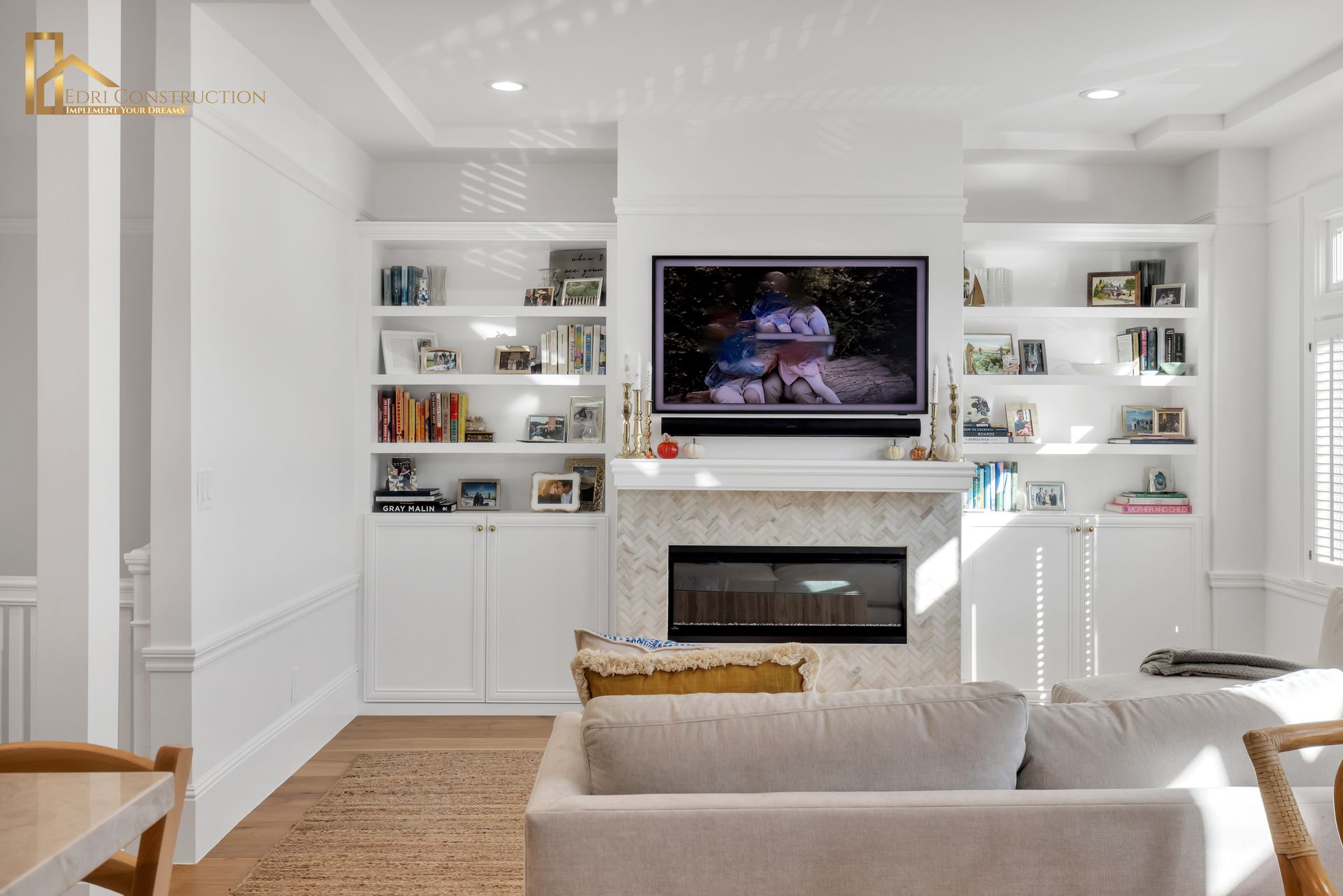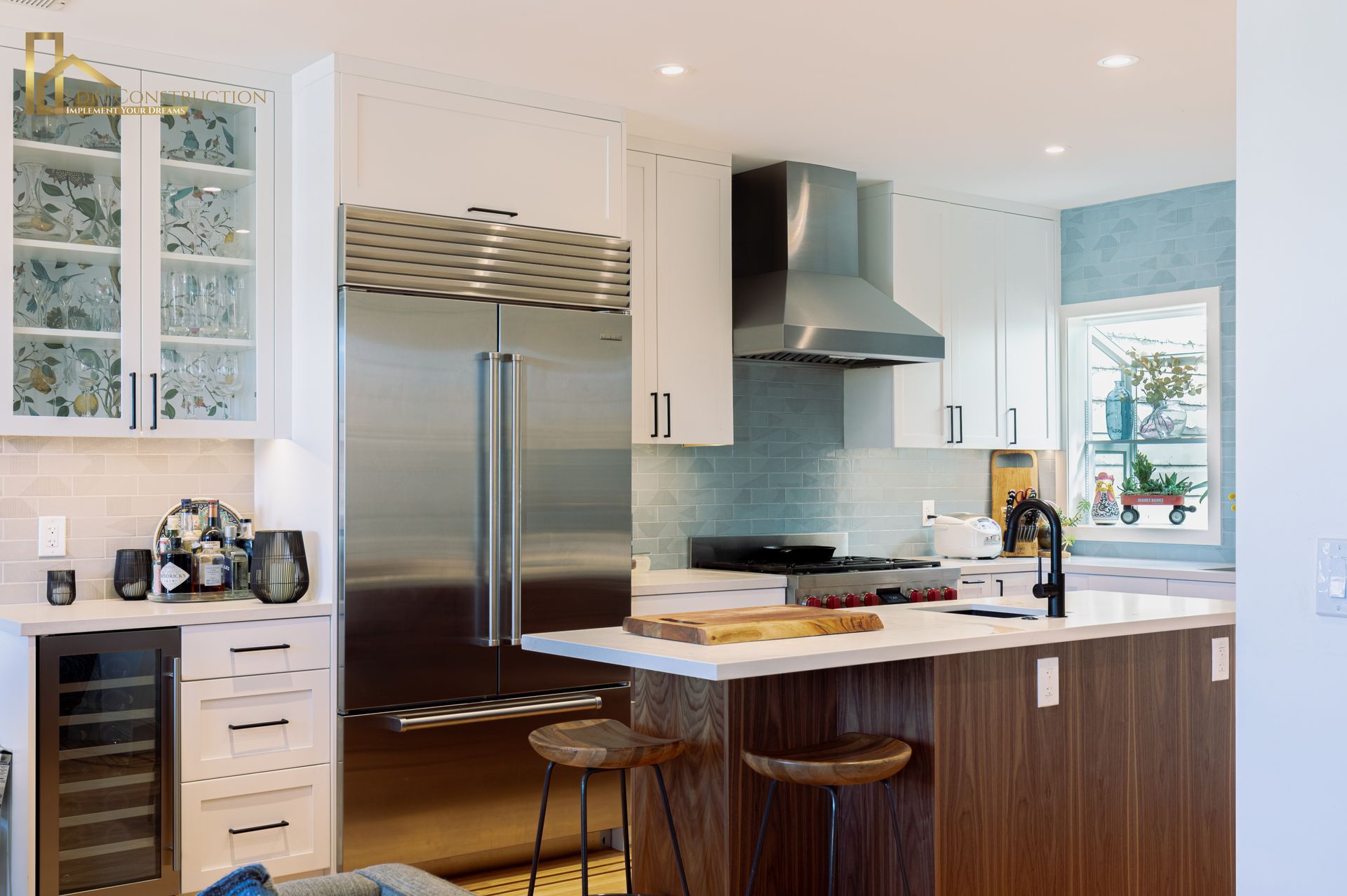What Common Mistakes Should I Avoid When Remodeling My Home?

INTRODUCTION
Embarking on a home remodeling project is an exhilarating adventure brimming with prospects to craft your ideal living environment. Whether you're envisioning a kitchen facelift, a bathroom metamorphosis, or an entire home overhaul, meticulous planning and keen attention to detail are paramount. Nonetheless, numerous homeowners stumble into typical traps that can thwart their remodeling endeavors, resulting in annoyance, setbacks, and unforeseen expenses.
Undoubtedly, renovating your home is a thrilling endeavor. It's a chance to breathe new life into your living space, tailor it to your needs, and infuse it with your personal style. From the moment you start envisioning the possibilities to the exhilarating day when you see your dream space come to life, every step of the journey is filled with excitement and anticipation.
However, it's essential to approach the remodeling process with careful planning and attention to detail. Without a solid plan in place, you may find yourself facing unexpected challenges, delays, and costs that can quickly turn your dream renovation into a nightmare.
One common pitfall that many homeowners encounter is underestimating the time and effort required for the project. From obtaining permits and sourcing materials to coordinating with contractors and managing the construction process, there are numerous tasks involved in a home remodel that can easily eat up more time than anticipated. By carefully planning out each phase of the project and setting realistic timelines, you can avoid getting bogged down in delays and keep your renovation on track.
Another common mistake is failing to set a realistic budget for the project. Home renovations can quickly spiral out of control if you're not careful, with costs escalating far beyond what you initially planned for. To avoid financial strain, it's essential to establish a budget upfront and stick to it as closely as possible. Be sure to account for not only the cost of materials and labor but also any unexpected expenses that may arise along the way.
Additionally, it's crucial to hire the right professionals for the job. While it may be tempting to cut costs by attempting a DIY approach or hiring the cheapest contractor you can find, this can often end up costing you more in the long run. A skilled and experienced contractor will ensure that the job is done right the first time, saving you time, money, and headaches in the process.
Not Setting a Realistic Budget

etting a practical budget is paramount when embarking on a remodeling journey. Beyond just factoring in the upfront expenses like materials and labor, it's crucial to anticipate any unforeseen costs that could crop up during the renovation process. Unfortunately, it's a common misstep for homeowners to either underestimate these expenses or overlook hidden fees, resulting in budgetary overruns and undue financial pressure. Therefore, before diving into your project headfirst, it's imperative to conduct a meticulous assessment of your finances. By carefully scrutinizing your financial standing, you can ascertain a realistic figure that you can comfortably allocate to your remodel, thereby mitigating the risk of financial strain down the line. This diligent approach ensures that you embark on your remodeling journey with clarity and confidence, enabling you to navigate potential challenges with ease while staying within your budgetary constraints.
Choosing the Wrong Contractor

Choosing the perfect home remodeling contractor plays a pivotal role in determining the outcome of your project. Sadly, numerous homeowners fall into the trap of hastily selecting the first contractor they come across or making decisions solely based on pricing. However, it's imperative to approach this decision with caution and conduct comprehensive research to thoroughly evaluate potential contractors before committing. Here are some crucial steps to ensure you select the right contractor for your home remodeling project:
Conduct Thorough Research
Take the time to research and compile a list of potential contractors in your area. Utilize online resources, such as review websites and contractor directories, to gather information about their credentials, services offered, and areas of expertise.
Check Licensing and Insurance
Verify that the contractors you're considering are properly licensed and insured to perform remodeling work in your area. This provides you with reassurance that they meet the necessary legal requirements and have the appropriate coverage in case of any accidents or damages during the project.
Assess Experience and Expertise
Look for contractors who have extensive experience in the type of remodeling work you require. Whether it's kitchen renovations, bathroom upgrades, or whole-house remodels, choosing a contractor with specialized expertise ensures that they have the skills and knowledge needed to deliver satisfactory results.
Read Reviews and Request References
Take the time to read reviews and testimonials from previous clients to gauge the contractor's reputation and track record. Additionally, don't hesitate to ask for references from past clients and follow up with them to inquire about their experience working with the contractor.
Evaluate Communication and Professionalism
Pay attention to how the contractor communicates and interacts with you during the initial consultation and throughout the hiring process. A professional contractor should be responsive, attentive to your needs, and transparent about the project timeline, costs, and any potential challenges.
By following these guidelines and taking the necessary precautions, you can ensure that you hire a reputable and qualified contractor who will deliver quality results for your home remodeling project. Remember, investing time and effort into selecting the right contractor upfront can save you from headaches and costly mistakes down the line, ultimately leading to a successful and satisfying remodeling experience.
Ignoring Energy Efficiency
In today's environmentally conscious world, prioritizing energy efficiency is crucial, yet often overlooked, especially during home remodeling projects. Ignoring this aspect can lead to increased energy bills and a less comfortable living environment. Therefore, when planning your remodel, it's essential to consider integrating energy-efficient features to reap both financial and environmental benefits.
One of the simplest yet most effective ways to enhance energy efficiency is by incorporating LED lighting throughout your home. LED bulbs consume significantly less energy than traditional incandescent bulbs while lasting much longer, thereby reducing both your electricity usage and the frequency of bulb replacements. Additionally, LED lighting emits less heat, helping to maintain a more comfortable indoor temperature.
Another key consideration is upgrading to energy-efficient appliances. Modern appliances are available with energy-saving features such as Energy Star ratings, which indicate superior energy efficiency compared to standard models. By investing in energy-efficient refrigerators, dishwashers, washing machines, and other household appliances, you can significantly reduce your energy consumption and lower your utility bills over time.
Furthermore, upgrading to insulated windows and doors can make a substantial difference in your home's energy efficiency. Insulated windows and doors help to minimize heat transfer, keeping your home warmer in the winter and cooler in the summer. This reduces the strain on your heating and cooling systems, resulting in lower energy usage and increased comfort year-round.
Additionally, consider improving your home's insulation to further enhance its energy efficiency. Proper insulation helps to regulate indoor temperatures, reducing the need for excessive heating and cooling. By sealing gaps and adding insulation in attics, walls, and crawl spaces, you can prevent energy loss and create a more comfortable indoor environment for your family.
Overlooking Functionality

While aesthetics undoubtedly play a significant role in home remodeling, it's crucial not to neglect functionality. Before embarking on major renovations like tearing down walls or reconfiguring layouts, it's essential to carefully assess how each space is utilized and identify the features that are most important to you. Prioritizing functionality ensures that your home not only looks beautiful but also serves your practical needs effectively.
In a kitchen remodel, for instance, it's essential to consider the flow of traffic and optimize workspace and storage options. A well-designed kitchen layout allows for efficient movement between cooking, prepping, and cleaning areas, enhancing the overall functionality of the space. Ample storage solutions, such as cabinets, drawers, and pantry space, help keep clutter at bay and ensure that essential items are easily accessible when needed.
Similarly, in a bathroom renovation, functionality should be a top priority. Factors such as accessibility, lighting, and ventilation can significantly impact the usability and comfort of the space. Incorporating features like grab bars, curbless showers, and adjustable showerheads can enhance accessibility for individuals with mobility limitations or aging in place. Adequate lighting, both natural and artificial, ensures visibility and safety, while proper ventilation helps prevent moisture buildup and mold growth, maintaining a healthy indoor environment.
Moreover, it's essential to consider the specific needs and preferences of your household members when planning your remodel. For example, families with young children may prioritize childproofing measures and durable, easy-to-clean surfaces, while pet owners may focus on incorporating pet-friendly features like built-in feeding stations or designated pet washing areas.
By carefully considering functionality in your remodeling project, you can create spaces that not only look stunning but also cater to your practical requirements. Whether it's optimizing kitchen workflow, enhancing bathroom accessibility, or accommodating specific lifestyle needs, prioritizing functionality ensures that your home renovation aligns with how you live and enhances your daily life.
Neglecting to Plan Ahead
A successful remodeling project hinges on proper planning. Unfortunately, many homeowners dive headfirst into renovations without crafting a detailed plan, setting themselves up for potential delays, budget overruns, and frustration. To avoid these pitfalls, it's crucial to invest time upfront in developing a comprehensive plan that encompasses every aspect of the project.
Before commencing your remodel, dedicate ample time to map out every detail, including design, layout, materials, and timeline. Rushing through this stage can result in costly mistakes and setbacks later on. By meticulously planning each step of the process, you can anticipate challenges, streamline workflows, and ensure a smoother execution overall.
Consider enlisting the expertise of a professional designer or architect to assist you in creating a cohesive plan tailored to your needs and budget. These professionals bring valuable insights, creative solutions, and industry knowledge to the table, helping you make informed decisions and avoid common pitfalls.
Start by outlining your goals and priorities for the remodel. Whether you're aiming to increase functionality, enhance aesthetics, or improve energy efficiency, clearly defining your objectives will guide the entire planning process. Next, assess the existing space and identify any structural or logistical considerations that may impact the design and implementation. When it comes to design and layout, think about how you use the space and what changes will best accommodate your lifestyle. Consider factors such as traffic flow, storage needs, and desired amenities to create a functional and visually appealing environment.
Selecting the right materials is another critical aspect of the planning process. Research various options for flooring, countertops, cabinetry, fixtures, and finishes to find the perfect balance of style, durability, and affordability. Keep your budget in mind and explore cost-effective alternatives that still meet your aesthetic preferences.
Creating a realistic timeline is essential for keeping your project on track and minimizing disruptions to your daily life. Factor in lead times for materials, permit approvals, and the availability of contractors to ensure a smooth and efficient construction process.
Underestimating Time Constraints
Undertaking a home remodeling project is a laborious endeavor that demands meticulous coordination and scheduling. Yet, it's all too common for homeowners to miscalculate the time required to complete their remodel, resulting in frustration and inconvenience. To avoid such setbacks, it's imperative to approach the project with realistic expectations regarding the time constraints involved and to anticipate potential delays that may arise along the way.
Before embarking on your remodel, it's essential to have a clear understanding of the time commitment required. Assess the scope of work involved, from demolition and construction to installation and finishing touches, and realistically evaluate how long each phase will take. Consider factors such as the size and complexity of the project, the availability of materials and labor, and any unforeseen challenges that may arise during the process.
Effective communication with your contractor is key to developing a realistic schedule that aligns with your needs and expectations. Be upfront about your timeline requirements and discuss any constraints or limitations that may impact the project's timeline. A reputable contractor will work with you to develop a comprehensive schedule that outlines the timeline for each phase of the remodel, allowing for adequate time for completion and addressing any potential delays proactively.
It's also crucial to factor in buffer time for unexpected setbacks or delays that may occur during the course of the project. Whether it's inclement weather, material shortages, or unforeseen structural issues, these factors can significantly impact the timeline and may require adjustments along the way. By building flexibility into your schedule, you can better manage these challenges and minimize their impact on the overall timeline.
Throughout the remodel, maintain open lines of communication with your contractor and stay informed about the progress of the project. Regular updates and check-ins will help ensure that the project stays on track and any issues are addressed promptly. Be prepared to make decisions in a timely manner and provide any necessary approvals or feedback to keep the project moving forward smoothly.
Sacrificing Quality for Cost

While it's understandable to seek savings during a remodeling endeavor, prioritizing cost over quality can have detrimental consequences. Too often, homeowners opt for the cheapest materials or compromise on skilled labor to adhere to a tight budget. However, this approach may lead to substandard outcomes that necessitate expensive fixes or replacements in the future. Instead of solely fixating on cost, it's essential to prioritize value by investing in top-notch materials and experienced professionals.
Choosing low-quality materials to cut costs might seem like a prudent decision initially, but it can ultimately backfire. Inferior materials are prone to premature wear and damage, resulting in frequent repairs or replacements that incur additional expenses over time. Moreover, they may lack the aesthetic appeal and durability of higher-quality alternatives, detracting from the overall look and longevity of your remodel. Similarly, opting for inexperienced or unskilled contractors to save money on labor can have dire consequences. While their services may come at a lower price point, they often lack the expertise and craftsmanship necessary to execute the project to the desired standard. As a result, you may encounter delays, mistakes, or even structural issues that require costly remedies to rectify.
Instead of prioritizing the lowest bid or cutting corners to reduce costs, it's prudent to focus on securing value for your investment. Invest in premium materials that offer durability, functionality, and aesthetic appeal, even if they come with a higher price tag upfront. Quality materials not only enhance the overall look and feel of your remodel but also provide long-lasting performance and durability, ultimately saving you money in the long term by reducing maintenance and replacement expenses.
Likewise, hiring experienced and reputable professionals ensures that your project is executed with precision and expertise. While skilled contractors may charge higher rates for their services, their proficiency and attention to detail result in superior outcomes and fewer complications throughout the remodeling process. By entrusting your project to competent professionals, you can enjoy peace of mind knowing that your investment is in capable hands and that the results will meet or exceed your expectations.
Overlooking Permit Requirements
Securing permits from your local government is a crucial step in the remodeling process, often overlooked by homeowners eager to dive into their projects. Despite assumptions that their renovations may not necessitate permits or that they can proceed without them, failing to obtain the necessary permits can lead to severe consequences such as fines, delays, and legal entanglements. Therefore, before embarking on your remodel, it's imperative to consult with your local building department to ascertain which permits are requisite for your specific project and ensure you acquire them before commencing any work.
The need for permits varies depending on the scope and nature of the remodeling project. While minor cosmetic updates like painting or replacing fixtures may not typically require permits, substantial renovations involving structural changes, electrical or plumbing work, or additions to the home almost always mandate permits. Examples of projects that commonly necessitate permits include kitchen remodels involving the relocation of plumbing or electrical lines, bathroom renovations involving changes to the layout or installation of new fixtures, and additions such as decks, patios, or room expansions.
Obtaining permits serves several essential purposes. Firstly, it ensures that your remodel complies with local building codes and regulations, guaranteeing the safety and structural integrity of your home. Building codes establish minimum standards for construction, electrical, plumbing, and other aspects of building projects, designed to safeguard occupants and preserve property values. By obtaining permits, you demonstrate your commitment to adhering to these standards, mitigating the risk of potential hazards or deficiencies in your remodel.
Secondly, permits provide oversight and accountability throughout the remodeling process. Building inspectors review construction plans and conduct inspections at various stages of the project to verify compliance with building codes and approved plans. These inspections help identify any issues or deviations from the approved plans early on, allowing for timely corrections and ensuring that the work proceeds according to established standards.
Neglecting Safety Precautions
Ensuring safety is paramount during any home remodeling project. Yet, it's a crucial aspect that often gets overlooked by homeowners amidst the excitement of renovation. Whether you're knocking down walls, rewiring electrical systems, or operating power tools, prioritizing safety measures is essential to safeguard yourself and your family from potential injuries or accidents.
To begin with, wearing appropriate safety gear is non-negotiable. Equip yourself with goggles to shield your eyes from flying debris, sturdy gloves to protect your hands from sharp edges or materials, and masks to prevent inhalation of dust or fumes. Additionally, donning closed-toe shoes with slip-resistant soles can provide stability and protection against accidental slips or falls.
Securing the work area is equally crucial to minimize hazards and prevent accidents. Ensure that the workspace is well-lit to enhance visibility and identify potential risks. Keep the area clean and organized by promptly removing debris, tools, and equipment after use to prevent tripping hazards. If working at heights, such as on ladders or scaffolding, ensure they are stable and properly secured to prevent falls.
When working with electrical systems or power tools, exercise caution and adhere to safety guidelines to avoid electrocution or injury. Always turn off power sources before performing any electrical work and use insulated tools to minimize the risk of shocks. Similarly, familiarize yourself with the proper operation of power tools and follow manufacturer instructions to prevent accidents or misuse.
Furthermore, it's essential to be mindful of structural integrity when remodeling your home. Before making any structural changes, consult with a professional to assess the potential impact on load-bearing walls or support structures. Taking shortcuts or disregarding structural considerations can compromise the stability of your home and pose serious safety risks.
Forgetting to Plan for the Future
When embarking on a home remodeling project, it's crucial to adopt a forward-thinking mindset and contemplate the long-term implications of your design choices. While it's natural to focus on current needs and preferences, overlooking future considerations can result in the need for additional renovations down the line. To ensure that your home remains functional and relevant for years to come, it's essential to anticipate how your lifestyle and requirements may evolve over time.
Before diving into your remodel, take the time to envision how your family dynamics and living requirements may change in the future. Consider factors such as growing families, aging relatives, or lifestyle shifts that could impact your home's functionality. By proactively planning for these changes, you can incorporate features that will allow your home to adapt and accommodate evolving needs seamlessly.
One crucial aspect to consider is the flexibility of your living spaces. Rather than rigidly defining rooms for specific purposes, strive to create versatile areas that can easily be reconfigured as your needs evolve. Open floor plans, movable partitions, and multifunctional furniture are excellent options for maximizing flexibility and ensuring that your home can adapt to changing circumstances.
Additionally, it's essential to incorporate universal design principles into your remodel to enhance accessibility and accommodate individuals of all ages and abilities. Features such as wider doorways, zero-step entrances, and lever-style door handles can make your home more inclusive and user-friendly for everyone. By prioritizing universal design, you can future-proof your home and ensure that it remains welcoming and comfortable for family members and visitors alike.
Furthermore, consider adding extra bedrooms or living spaces to accommodate future growth or changing household dynamics. Whether it's expanding an existing room or finishing a basement or attic, creating additional space provides flexibility and versatility for accommodating guests, hobbies, or home-based businesses.
Conclusion
Remodeling your home is an exciting opportunity to create a space that reflects your style, personality, and practical needs. However, it's essential to approach the process with careful planning, attention to detail, and a realistic understanding of the challenges involved. By avoiding these common mistakes and following the tips outlined in this guide, you can ensure a successful remodeling project that transforms your house into the home of your dreams.
For more information on home remodeling ideas, trends, and inspiration, contact [Home Remodeling Professionals](#) in your area for a consultation. With their expertise and guidance, you can bring your vision to life and create a home that you'll love for years to come.
Frequently Asked Questions About Home Remodeling
What is home remodeling?
Home remodeling involves making changes to an existing home's structure, layout, or design to improve its functionality, aesthetics, or value. This can include projects such as kitchen renovations, bathroom remodels, room additions, or exterior updates.
How do I find the right home remodeling contractor?
Finding the right home remodeling contractor involves research, referrals, and careful vetting. Start by asking friends, family, and neighbors for recommendations, and then research local contractors online. Look for contractors who are licensed, insured, and experienced in the type of project you're planning. Read reviews, ask for references, and interview multiple contractors before making a decision.
What are some common types of home remodeling projects?**
Some common types of home remodeling projects include kitchen remodeling, bathroom renovations, basement finishing, exterior home renovations (such as siding replacement or adding a deck), room additions, and whole-house renovations.
How much does home remodeling cost?
The cost of home remodeling can vary widely depending on the scope of the project, the materials used, and the location. Small projects like updating a bathroom or kitchen can cost a few thousand dollars, while larger projects like a whole-house renovation can cost tens or even hundreds of thousands of dollars. It's essential to get multiple quotes from contractors and budget carefully to avoid overspending.
How long does home remodeling take?
The duration of a home remodeling project depends on factors such as the size and complexity of the project, the availability of materials and labor, and any unexpected delays that may arise. Small projects like a bathroom remodel can take a few weeks, while larger projects like a whole-house renovation can take several months or even a year or more to complete.
How can I finance my home remodeling project?
There are several financing options available for home remodeling projects, including personal savings, home equity loans or lines of credit, cash-out refinancing, and contractor financing. Explore these options and choose the one that best fits your financial situation and goals.
What should I consider when planning a home remodeling project?
When planning a home remodeling project, consider factors such as your budget, timeline, desired outcome, and the needs of your household. Think about how you use the space, any specific features or amenities you want to include, and how the project will impact your home's value and functionality.
How can I ensure a successful home remodeling project? or Question
To ensure a successful home remodeling project, it's essential to plan carefully, communicate openly with your contractor, stick to your budget and timeline, and be flexible and adaptable when unexpected challenges arise. Working with experienced professionals and staying involved in the process can also help ensure a positive outcome.
To ensure a successful home remodeling project, it's essential to plan carefully, communicate openly with your contractor, stick to your budget and timeline, and be flexible and adaptable when unexpected challenges arise. Working with experienced professionals and staying involved in the process can also help ensure a positive outcome.
What are some popular home remodeling trends?
Some popular home remodeling trends include open-concept floor plans, smart home technology, energy-efficient upgrades, sustainable materials, and multi-functional spaces. Keep an eye on design blogs, magazines, and social media for inspiration and ideas.
How can I get started with my home remodeling project?
To get started with your home remodeling project, begin by researching local contractors, collecting inspiration and ideas, and developing a clear plan and budget. Schedule consultations with potential contractors to discuss your project and get estimates, and then start the remodeling process once you've selected the right team for the job.










